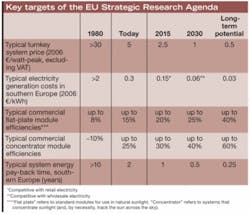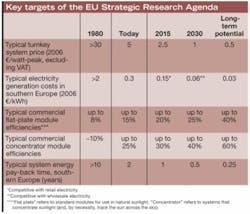Solar electricity: its time has come
Wim C. Sinke
On June 12 the European Photovoltaic (PV) Technology Platform presented its Strategic Research Agenda (SRA), an important milestone in reaching technology and development goals for solar electricity in Europe.1 The SRA was presented in Berlin, in the heart of what is perhaps the most active and ambitious country in the world in the field of photovoltaic solar energy. The SRA provides an overview of the short‑, medium-, and long-term development goals of photovoltaic solar-energy technology as seen by experts in the field. It outlines the research fields and topics to be addressed to enable this development.
The overall short-term target of the SRA is to reach grid parity in southern Europe by 2015. Grid parity refers to the condition of equality between the cost of generating solar electricity using photovoltaic technology and the local retail price of electricity. At this point, when households can sell solar electricity to the grid at a price equal to that paid for electricity consumed from the grid, called “net metering,” they can recover the investment in a grid-connected PV system. In some cases, solar electricity is able to compete with peak power-the electricity produced and used in times of maximum demand-already today.
After 2015, the generation cost of solar electricity will continue to decrease, and by 2020, grid parity will have been reached in most of Europe. In the longer term, solar electricity will even become substantially cheaper than wholesale electricity from conventional sources in addition to the environmental and other benefits of solar energy.
Zooming in on the contents of the SRA, one of the most striking recommendations of the Platform is not to make a choice between the different existing technology options at this stage. The photovoltaic industry has not made such a choice either. It is more desirable to develop a portfolio of options with ambitious common development targets than to focus on one or two particular technologies (see table). Indeed, “overselling” a single photovoltaic technology option could severely harm development of the PV market as a whole, whether it concerns a commercially available one or a high-risk, high-potential development. It’s easy to underestimate what it takes to develop a PV product with a 25-year warranty and reasonable total-area module efficiency (for example, greater than 10%) for large-scale professional use. Available photovoltaic technology is developing in a robust but unrevolutionary manner. This development is impressive and sufficient as it is. The European Platform anticipates no earth-shattering breakthrough in PV technology. Rather, the breakthrough is here: it is photovoltaics. It makes no sense to wait for “much better and cheaper technology that will be available soon.” Only by investing in PV now will such options ever become available.
Of course, a preferred technology may find favor based on demonstrated superiority at a later stage. Each of the options has its own strengths and a large potential for cost reduction as well as performance enhancement. More specifically, the potential for cost reduction of all technologies that are commercially available today, such as wafer-based crystalline silicon, thin-film silicon, thin-film cadmium telluride, thin-film copper indium diselenide, and related compounds, appears to be sufficient to enable grid parity, and perhaps even significantly more than that. For this reason it is incorrect to state (as is often done) that PV needs a “breakthrough” to become competitive. Such a statement is sometimes used as an excuse to postpone action. I don’t suggest, however, that cost reduction is simple or straightforward. On the contrary: the SRA has been prepared to facilitate the joining of R&D forces on a European level to adequately face the huge challenges ahead.
The final generation cost of electricity from PV is determined by the price of complete turnkey systems (as well as the yearly insolation, the costs of operation and maintenance, the depreciation time, the interest rate, and other factors) and not just the price of the solar modules. The modules account for typically 50% to 70% of the turnkey system price, emphasizing the importance of bringing down the so-called balance-of-system costs-the costs of all system components except modules and labor (see “Cost versus price,” above). The challenge is to realize the cost reductions while maintaining or even improving lifetime and reliability of all system components and the system as a whole.
The crucial goal of R&D on alternate PV technology is ultimately to bring down the cost of electricity from PV into the range of wholesale electricity prices or even avoided fuel costs, as well as to develop new application possibilities such as electricity-generating (visually transparent) windows, and many more.
The PV industry is one of the fastest growing high-tech sectors in the world. With an estimated 100,000 jobs, €12 billion (US$17 billion) turnover, and more than 40% annual growth rates, the PV sector not only provides an essential ingredient for the global transition to a sustainable energy system, it provides a huge economic opportunity.
With the publication of a consolidated European research agenda for photovoltaic solar energy, the PV Technology Platform has reached an important milestone. It emphasizes and quantifies the enormous potential of photovoltaics and the determination of the European PV sector to make the solar future a reality.
Tell us what you think about this article. Send an e-mail to [email protected].
Cost versus price
It is important to distinguish clearly between cost and price. Prices determine the actual economics of electricity generation by PV, but cannot be addressed directly by R&D. Costs can be addressed by R&D through the implementation of results in manufacturing and installation. The price of a turnkey system includes all profit margins in the value chain up to the point of system operation and determines to a large extent the levelized cost of electricity generation, normally not taking into account a profit margin for the owner or operator of a system. Note that in the concept of grid parity, in which households may own the system, retail electricity prices are by definition compared with PV-generation costs, assuming that such costs are calculated using appropriate values for the depreciation time and interest rate. At the point of grid parity, there may not yet be a financial profit for the owner, but there is a profit for the environment.
Wim C. Sinke is chairman of Working Group 3: Science, Technology, and Applications of the European Photovoltaic Technology Platform; www.eupvplatform.org; Energy Research Centre of the Netherlands ECN, PO Box 1, NL-1755 ZG Petten, Netherlands; e-mail: [email protected].


